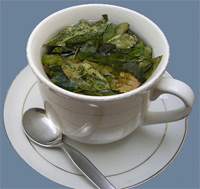After landing at Cusco Peru‘s two-mile high airport, we are greeted by colorfully-dressed Incas who hand us cups of hot tea. “¡Bienvenidos a Cusco!” A delightful welcome to the former center of the Incan Empire. but the tea also serves an important purpose—the prevention of altitude sickness.
 The tea we are offered at the airport, and again in our hotel lobby, is mate de coca—brewed from leaves of the coca plant. Coca is best known to North Americans as the source of the drug cocaine, which is actually a highly processed derivative of the coca leaf. Because of its association with the drug, coca is banned in the U.S.
The tea we are offered at the airport, and again in our hotel lobby, is mate de coca—brewed from leaves of the coca plant. Coca is best known to North Americans as the source of the drug cocaine, which is actually a highly processed derivative of the coca leaf. Because of its association with the drug, coca is banned in the U.S.
In the Andes, where it is legal, coca is an age-old tonic and a remedy for many ailments. It enhances mood, without dependency or toxicity; is a natural energizer, similar to coffee; is rich in vitamins and minerals; relieves dizziness, headaches and stomach problems; and aids in weight loss and child-birth.
Coca leaves can be chewed, brewed, smoked, or made into candy and baked goods. Shamans in the Andes smoke it for “magical” purposes—to enter the spirit world and to prognosticate the future in the tea leaves.
In the Incan empire, coca was considered to be very special, sometimes magical, and its use was controlled. After the conquest, the Catholic Church tried to forbid it, because of its ties to the old religion, but they found that in the high altitude without the coca, the natives had trouble working the fields and mining the gold, so the church itself cultivated the plants and distributed the leaves to the workers.
The world’s most popular coca product is Coca Cola™. Made from the extract of coca leaves mixed with kola nuts, it was created in 1885, and sold as a tonic. Coca Cola™ did contain cocaine (commonly used in 19th century patent medicines) until 1929! When it became known that cocaine was potentially harmful, the company had a problem. If it removed the coca from its recipe, could it still call its product Coca Cola™? On the other hand, if it did not remove the cocaine, there could be a boycott of the drink. Their solution was to devise an extraction process in which the coca leaves were ground, mixed with sawdust, soaked in bicarbonate of soda, percolated with toluene, and steam blasted. The result was then mixed with powdered kola nuts and pasteurized—preserving the taste while eliminating the drug effects. Pepsi™, by the way, does not use coca leaves in its recipe!
Today there are opponents and supporters of coca, but for visitors to Peru and other Andean countries, the tasty coca tea is a harmless antidote to the ills of altitude.
